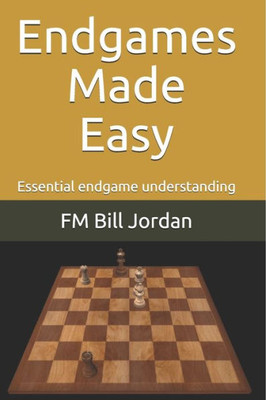

Endgames Made Easy
Independently published
ISBN13:
9781718135284
$16.64
Endgames Made Easy This book has many diagrams. You do not need a chess set and board to read this book. It is designed to be read several times. Each time it is reread, you may grasp points that were previously obscure to you. The book draws from many examples that the author has used in years of chess coaching. Why this book? In recent decades a high proportion of endgame books are quite advanced. Many of these are great books. However many of these books presume good basic endgame knowledge, say that what you would expect of a played rated 2000 ELO or candidate master strength. Its my observation after many years of playing and coaching that average club players typically have major gaps in their basic endgame knowledge. This book is designed to help fill the gap. For the sake of completeness, some very basic knowledge is included, so that the book will be useful for novices as well as club players. To play endgames strongly you do not need to know thousands of positions. A good understanding of basic principles, knowledge of some key positions and the ability to calculate well will go a long way. Why learn endings? Some players make an interesting point, why study the ending if I don't get many? Well, there is lots of reasons. The number of endings will increase as general playing strength increases. This is because players increase their ability to survive middlegames. The number of endgames will also increase if playing more evenly matched opponents. If neither player makes tactical mistakes, then an endgame is very likely. Even if you don't have an ending, endgame study may create ideas useful for the middlegame, especially positional ideas. Because you have so few pieces, placement of the pieces becomes all that more important. More importantly, you will know what endings to aim for. In many games between good players, one or both players has had option to exchange into ending at some point. If your ending understanding is weak, how will you know when to exchange and when not to? Playing for an ending, is sometimes the best way to exploit a positional advantage in pawn structure. With fewer pieces on, active piece play is less likely to compensate for weak squares and weak pawns. The idea that endings are boring is a British Junior myth. Some of the greatest brilliancies are in endings. You only need to look at Chernev's Practical Chess Endings to confirm this. Endings should be learned backwards, knowledge will be built from earlier knowledge. Capablanca said endings should be learned first, then middlegames with respect to the endings, then the openings with respect to middlegame and endgame. Endings are the ultimate test, as they are the most removed from the initial position. Positions in this phase are more the result of what you created, than earlier phases, and are the most removed from the start position and memorised opening moves. Study in the ending tends to be more rewarding than studying other phases of the game. In 20 hours you could cover an awful lot on many endings, but in the same time you would be lucky to absorb one opening variation. Strength in the endgame, gives you great chance to come back from earlier reverses and good endgame players are good endgame swindlers. To get stronger as the game goes on, is a good feeling. To be a strong player you must be good at endgames. What this book includes. Topics include drawing, basic concepts, lone king endgames, pawn endings, pawnless endings, piece versus pawns, rook endings, minor piece endings, queen endings and other endings. There are summaries of key points of each section. See my authors page for information about my background and other books.
- | Author: Bill Jordan
- | Publisher: Independently published
- | Publication Date: Sep 28, 2018
- | Number of Pages: 174 pages
- | Language: English
- | Binding: Paperback
- | ISBN-10: 1718135289
- | ISBN-13: 9781718135284
- Author:
- Bill Jordan
- Publisher:
- Independently published
- Publication Date:
- Sep 28, 2018
- Number of pages:
- 174 pages
- Language:
- English
- Binding:
- Paperback
- ISBN-10:
- 1718135289
- ISBN-13:
- 9781718135284





